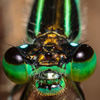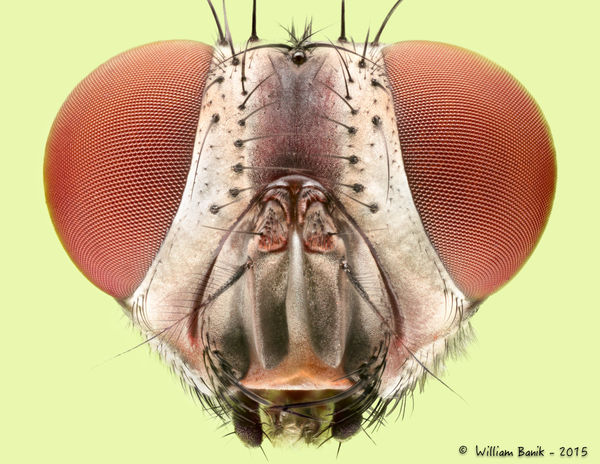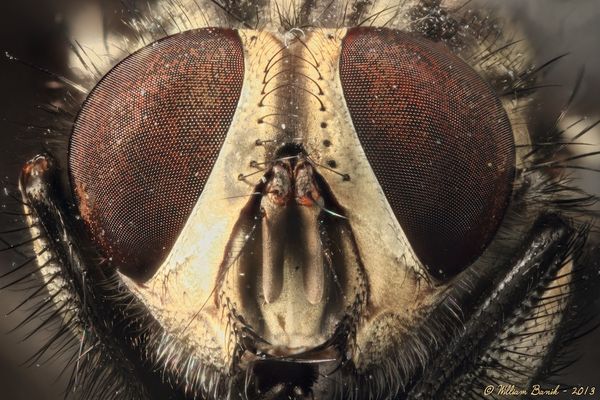Fly Stack Revisited
Jan 22, 2015 23:55:39 #
One of the first stacks I ever attempted when I started macro was a fly head on. I forgot how just getting the subject square with the camera is a laborious task that took more time then shooting the stack. Its a difficult subject to stack head on as the overlaps give the stacking program fits. A lot of labor went into touching up in Zerene and Photoshop but this latest effort is my best to date. Still room for improvement by strides were made and new ideas for the next stack were formulated.
Shot specs - Canon 5D-III, Sigma 105 Tube lens Olympus LMPlan FL 10X /.025 objective, ISO100, SS 1/200, Dual flash 600EX-RT and 430EX II. Manual stack with Zeiss fine focus block. 200 images ~7:1 with a quasi-square crop.
My first attempt from March-2013 is included as well. Shot with T2i, MP-E 65, 430 EX II and Nikon SB-26, ~4.5:1.
Shot specs - Canon 5D-III, Sigma 105 Tube lens Olympus LMPlan FL 10X /.025 objective, ISO100, SS 1/200, Dual flash 600EX-RT and 430EX II. Manual stack with Zeiss fine focus block. 200 images ~7:1 with a quasi-square crop.
My first attempt from March-2013 is included as well. Shot with T2i, MP-E 65, 430 EX II and Nikon SB-26, ~4.5:1.
Jan 23, 2015 00:15:42 #
Jan 23, 2015 00:19:39 #
Stellar. The lighting is so nice on the latest, without the blown highlights that appeared in the first.
Jan 23, 2015 02:49:15 #
Looks great! I can see where the overlap was giving the program a run for the money on the first one. I would love to see the first one repeated with a D800e or better yet, an D810 :thumbup: Even though I'm not completely certain more pixels would have helped in this case or not.
Did you stack TIFFs? Do you think bigger steps (less overlap) might have worked better?
Did you stack TIFFs? Do you think bigger steps (less overlap) might have worked better?
Jan 23, 2015 06:13:14 #
This is really nice work. Love the detail and how sharp it is. Would like to give something like this a try but I can only imagine how difficult it must have been. Thanks for the post and for inspiring me to keep on learning.
Jan 23, 2015 08:18:31 #
Jan 23, 2015 08:22:17 #
LoneRangeFinder wrote:
Thanks Allen, Looking back at the old photo I realize how much my understanding of macro-illumination has grown. Still not completely satisfied, as I keep waffling between single source and dual source illumination. I don't know if I'll ever figure out which I like best.Stellar. The lighting is so nice on the latest, without the blown highlights that appeared in the first.
Jan 23, 2015 09:52:28 #
Flyextreme wrote:
Thanks Bill The best way I have found to eliminate overlap errors is proper exposure throughout the entire dynamic range of the subject. I think this is the main issue with this photo. It is a difficult subject to illuminate properly with the color range muddied whites to deep blacks. With flash it is very hard to pinpoint the varying illumination intensities needed to properly expose the black and brown hairs without blowing out the whites in the face. Did you stack TIFFs? Do you think bigger steps (less overlap) might have worked better?
I tried to address this with bracket shooting and continuous LED lighting but it ended up being an exercise in futility. Long shutter times needed to properly expose the darker areas ended up being too noisy. Subsequent merging of the bracketed shots and stacking in Zerene produced an image with a considerable loss of detail. Longer exposure with continuous lighting has another drawback, hot pixels. In live view the sensor heats up - so do individual pixels and they get recorded as a bright green, red, or blue dots. Not a big issue with a 20 image stack, with a 200 image stack, it is cumbersome to edit out frame-by frame. Easy fix is to clone out the area in LR or PP after stacking but I like to avoid this whenever possible.
I need to work on smaller diffusers that mount directly on the flash, or improve at the art using flash with a small diffuser that envelopes the subject. Id also like to figure out how to shoot exposure brackets with flash. I know it can be done but havent taken the time to read the manual yet. It needs to be an automated bracket with a timed delay between shots to allow the shutter and mirror vibrations to settle. I dont see manually switching power levels on the flash for a 200 frame x3 bracket exposure as a long term repeatable exercise, for me .
Even with proper illumination stacking algorithm has an issue with overlaps. It gets confused with what goes in front and what goes in back since both portions are in focus as we push/pull the lens through the subjects focal planes. This produces translucent foreground hairs which compounds the overlap mess. Usually this can be fixed with slabbing (stacking substacks). In the case of this image, substacking improved the results. However, the lack of proper exposure on the hairs muddled the contrast enough that the Zerene just cant resolve the differences. I could try area specific contrast adjustments in LightRoom before exporting the frames to Zerene and see if that helps. It would be easier just to get it correct in camera.
Id like to visit this subject again with the OM-D E-M1. I find the higher pixel density produces sharper stacks, to my eyeballs. It wont resolve the lack of contrast definition in the fine hair overlap though. That needs to be addressed in the illumination setup/procedure.
I shoot RAW, import into LR make basic global adjustments then export directly from LR into Zerene. Lightroom exports a TIFF file. No, I dont think less overlap would have resolved the issue. Estimated DoF for numerical aperture of the objective (0.25) is .0088mm. Step size used was .0050mm. I like to keep the overlap in the 50% range. Perhaps a smaller overlap is an exercise worth exploring after I work out bracketing with flash.
Jan 23, 2015 09:56:58 #
waltchilds wrote:
Thanks Walt, your comments are well received. I enjoy tabletop stacking. A lot can be learned on the rig that can be applied in the field. That said you need a fair amount of patience to do it.This is really nice work. Love the detail and how sharp it is. Would like to give something like this a try but I can only imagine how difficult it must have been. Thanks for the post and for inspiring me to keep on learning.
Jan 23, 2015 10:13:09 #
A-PeeR wrote:
I suppose you could utilize some bracketing on these, but yikes, that would give you 600 images to pick through. I don't employ much batch processing-- but that might work to adjust exposure.Looking back at the old photo I realize how much my understanding of macro-illumination has grown. Still not completely satisfied, as I keep waffling between single source and dual source illumination. I don't know if I'll ever figure out which I like best.
On the topic of single source/dual source, I did note that you were using the twin flash set-up. Were these sources attached to the camera/lens? That's how my Nikon units work: they snap on to a ring that threads in like a filter to the front of the lens. The challenge with lighting has always been that if a focusing rail was utilized with these units then the lighting also changed as it moved incrementally closer to the subject. In the "studio" this is not an issue as I mount a sole source on the bench.
Now with using the AF/focusing ring to collect stacks, I can use this macro light set-up because the lens to object distance remains the same.
Oops, I just saw your post to Bill.... :oops: :oops:
Jan 23, 2015 12:05:30 #
i love the 1st pic,those nasty fly's sure are interesting,
i have shot many.
i have shot many.
Jan 23, 2015 12:24:56 #
stunning! Very clean subject too. I like the yellow background and the idea of keeping only key subject parts. Now you need to add nomenclature and lines/arrows and put this in a book.
Jan 23, 2015 22:50:17 #
The 430EXII and 600RT-EX are large flashes so I cant mount them on the lens. I have them on Manfrotto Magic Arms so they are stationary and free of the camera. Yes, twin macro flashes on the end of the lens can be problematic when running stacks. Yes, another advantage of the focus stacking with the lens is the flash to subject distance remains the same.
Jan 23, 2015 22:51:04 #
tinusbum wrote:
Thanks Tom, yeah I find them interesting as well.i love the 1st pic,those nasty fly's sure are interesting,
i have shot many.
i have shot many.
Jan 23, 2015 22:52:31 #
pfrancke wrote:
Thanks Piet, yes the dual flash does give it that flat textbook look. Going to shoot another stack with a single flash and see how that turns out.stunning! Very clean subject too. I like the yellow background and the idea of keeping only key subject parts. Now you need to add nomenclature and lines/arrows and put this in a book.
If you want to reply, then register here. Registration is free and your account is created instantly, so you can post right away.







